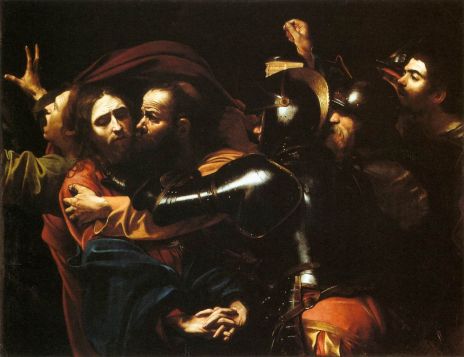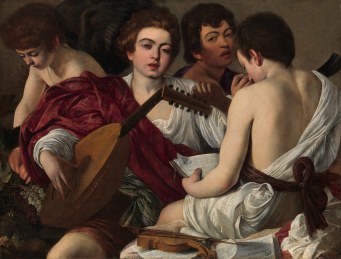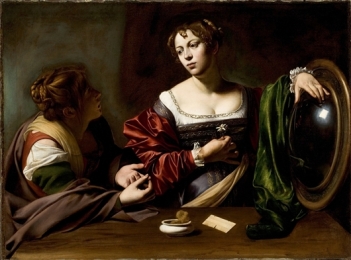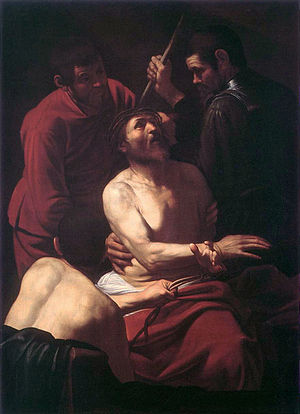by Noti Klagka
This post explores the scholarship on Michelangelo da Caravaggio in the pages of The Burlington Magazine and reveals the crucial role played by the Magazine in the critical reception of this artist. Caravaggio has definitely been the most popular 17th century Italian artist published in the Burlington: 59 main articles and 210 shorter notes cover his work, whereas only 18 main articles are dedicated to Guido Reni, 21 to Guercino, and only 4 to Annibale Carracci.
 The Burlington articles are highly indicative of Caravaggio’s increasing popularity in the course of the 20th century and by the beginning of the 21st century show the extent of the phenomenon that Richard Spear has eloquently defined as ‘Caravaggiomania’. [1] The number of book reviews recently dedicated to the artist is, in fact, impressive and confirms Spear’s ‘mania’ diagnosis: 35 new books on Caravaggio have been reviewed in the Burlington since the year 2000, a rather large number in comparison to the 10 devoted to Peter Paul Rubens.
The Burlington articles are highly indicative of Caravaggio’s increasing popularity in the course of the 20th century and by the beginning of the 21st century show the extent of the phenomenon that Richard Spear has eloquently defined as ‘Caravaggiomania’. [1] The number of book reviews recently dedicated to the artist is, in fact, impressive and confirms Spear’s ‘mania’ diagnosis: 35 new books on Caravaggio have been reviewed in the Burlington since the year 2000, a rather large number in comparison to the 10 devoted to Peter Paul Rubens.

This post focuses on the most important articles on Caravaggio in the second half of the century. Then, pioneer scholars of 17th century art – such as Denis Mahon, Jacob Hess, Sergio Benedetti, Luigi Salerno, Mina Gregori, Keith Christiansen, and not least the Burlington Editor himself, Benedict Nicolson – chose to publish their findings in the pages of the Magazine.
The turning point in Caravaggio’s reception was undoubtedly the 1951 Milan exhibition in Palazzo Reale, organised by esteemed Italian art historian Roberto Longhi. Although the decisive turn in Caravaggio studies took place in Italy, and it was the outcome of Longhi’s lifelong efforts, the English-speaking scholars contributed greatly to the establishment of the artist’s work and published on significant aspects of his connoisseurship, such as chronology and attribution. The impact of the Longhi exhibition was apparent in the Burlington pages through a series of articles which discovered or ‘revised’, as Mahon himself put it, much important data concerning the artist’s life and work. These articles truly laid the foundations of future Caravaggio studies.
The first groundbreaking article on the connoisseurship of Caravaggio was published in the Burlington in June 1951: Hess’s article on the chronology of the Contarelli chapel in San Luigi dei Francesi in Rome. [2] This was followed by a thorough reconsideration of the artist’s chronology by Mahon, published in the July and September 1951 issues of the Burlington, entitled ‘Egregius in Urbe Pictor: Caravaggio revised’[3] and ‘Caravaggio’s Chronology again’.[4] Additionally, a newly discovered document concerning Caravaggio’s death was published for the first time by literature scholar Ottis Green, and was framed in an art-historical context by Mahon.[5]
Nicolson’s editorial in July 1951 was devoted to the Milan exhibition and had the revealing title of ‘the First Modern Painter’. [6] There Nicolson included Caravaggio in the ‘Pantheon’ of modern painters, the precursors of modernity whose work lead to 19th century realism and Courbet. Both Nicolson and Mahon stressed the importance of the Milan exhibition and foreseen the intensification of new scholarship on Caravaggio. [7]
New Caravaggio attributions in The Burlington Magazine
 In the 1950s many of now celebrated Caravaggios had not yet been added to the artist’s oeuvre. For instance, Judith slaying Olofernes (Palazzo Barberini, Rome – illustrated here left), today one of Caravaggio’s most famous works, was only rediscovered by Longhi in 1950 and was added to the Milan exhibition only at the last moment; it didn’t make it into the catalogue.
In the 1950s many of now celebrated Caravaggios had not yet been added to the artist’s oeuvre. For instance, Judith slaying Olofernes (Palazzo Barberini, Rome – illustrated here left), today one of Caravaggio’s most famous works, was only rediscovered by Longhi in 1950 and was added to the Milan exhibition only at the last moment; it didn’t make it into the catalogue.
As a result of the newly developed interest on the painter, between 1952 and 1993, eight more paintings were added to Caravaggio’s work. These attributions were first published in the Burlington.
- The now celebrated Musicians in the Metropolitan Museum of Art (New York, illustrated here), was discovered by Mahon in 1952 and published in the Burlington’s January issue[8] as Una Musica, with a triumphant article of twenty pages. Mahon, as proud as Sherlock Holmes, described the identification of the lost canvas through a ‘tiny unprofessional photograph of a picture [that] he had seen in the collection of a private amateur in an English country house’.[9]

- In 1956, with the title ‘A late Caravaggio rediscovered’, [10] Mahon identified as an original Caravaggio the painting Christ at Column, today in Musée des Beaux Arts, Rouen. The canvas was firstly discovered by Longhi in a private Swiss collection, and was included in the Milan exhibition as copy.
- 1974 was another significant year for Caravaggio studies, marked by the exhibition in Palazzo Pitti in Florence, ‘Caravaggio and the Caravaggesque’ (Caravaggio e i Caravaggeschi). Its importance was recognised in the Burlington October 1974 issue. Nicolson
 ’s editorial, the third devoted to the artist, commented extensively the Florentine exhibition and the popularity of the artist in the British isles.[11] In the same issue, The conversion of the Magdalen, known also as ‘The Detroit Conversion’ orthe ‘Alzaga Caravaggio’ (illustrated here left), was newly attributed to the artist with a detailed article that covered all the aspects of the work. The painting’s iconography was investigated by Frederick Cummings, Curator of the Detroit Museum of Fine Arts.[12] A thorough technical analysis was undertaken and published by the museum’s conservators; whereas Luigi Spezzaferro explored the documentary findings around this picture.[13] Finally, its wider art historical implications were discussed by Luigi Salerno.[14]
’s editorial, the third devoted to the artist, commented extensively the Florentine exhibition and the popularity of the artist in the British isles.[11] In the same issue, The conversion of the Magdalen, known also as ‘The Detroit Conversion’ orthe ‘Alzaga Caravaggio’ (illustrated here left), was newly attributed to the artist with a detailed article that covered all the aspects of the work. The painting’s iconography was investigated by Frederick Cummings, Curator of the Detroit Museum of Fine Arts.[12] A thorough technical analysis was undertaken and published by the museum’s conservators; whereas Luigi Spezzaferro explored the documentary findings around this picture.[13] Finally, its wider art historical implications were discussed by Luigi Salerno.[14]
- In the same issue Gregori, in the article ‘A New Painting and Some Observations on Caravaggio’s Journey to Malta’, attributed to Caravaggio the half length Portrait of Alof de Wignacourt, then on the Florentine art market.[15]
- Two years later, in October 1976, there followed another addendum to Caravaggio by Gregori, who attributed to the artist the Cecconi Crowning with Thorns (Palazzo degli Alberti, Prato, illustrated here right) when she ‘reconsidered’ the canvas after its restoration.

- In January 1988, Mahon announced his discovery of the original canvas of the Cardsharps with his article “Fresh Light on Caravaggio’s Earliest Period: His ‘Cardsharps’ Recovered’.[16] (the Cardsharps is illustrated above just after the first paragraph of this blog). This article was followed by an appendix, which included a detailed technical report on the canvas by Christiansen.[17]
- In January 1990, Mahon, once again in collaboration with Christiansen, authenticated Wildenstein’s, Singing ‘Lute-Player’, then on loan to the Metropolitan Museum in New York.[18] Christiansen then published his article ‘Some Observations on the Relationship between Caravaggio’s Two Treatments of the ‘Lute-Player’, in the Burlington.[19]
- In November 1993, Benedetti in collaboration with Francesca Cappelletti, attributed to Caravaggio The Taking of Christ (Dublin, National Gallery – illustrated here at the top of the page), defining it as ‘a masterpiece rediscovered’ and supplemented his article with ‘the documentary evidence of the early history’ of the painting.
During the second half of the 20th century, then, the Burlington contributed much to the shaping of Caravaggio’s oeuvre as we know it today. The next post will compare articles on Caravaggio written in the first half of the century, and show how the Burlington contributors were then mostly concerned with matters of style, and focused on the interpretation of Caravaggio’s unique canvases rather than on questions of connoisseurship.
NK December 2016
[1] R. Spear, ‘Caravaggiomania’, Αrt in America, 98 (2010), pp. 116-118.
[2] J. Hess, ‘The Chronology of the Contarelli Chapel’, The Burlington Magazine, Vol.93, No.579, June 1951, pp.186-201.
[3] D. Mahon, ‘Egregius in Urbe Pictor: Caravaggio Revised’, The Burlington Magazine, Vol. 93, No.580, July 1951, pp. 222-235.
[4] D. Mahon, ‘Caravaggio’s Chronology Again’, The Burlington Magazine, Vol. 93, No. 582, September 1951, pp. 286-292.
[5] O. Green and D. Mahon, ‘Caravaggio’s Death: A New Document’, The Burlington Magazine, Vol. 93, No. 579, June 1951, pp. 202-204.
[6] Editorial, ‘The first modern painter’, The Burlington Magazine, Vol. 93, No. 580, July 1951, p.211.
[7] D. Mahon, ‘Caravaggio’s Chronology Again’, Vol. 93, No. 580, July 1951, p. 292.
[8] D. Mahon, ‘Addenda to Caravaggio’, The Burlington Magazine, Vol.94, No.586, January 1952, pp.2-23.
[9] Ibid, p. 3.
[10] D. Mahon, ‘A Late Caravaggio Rediscovered’, The Burlington Magazine, Vol.98, No. 640, July 1956, pp.224-229.
[11] Editorial, ‘Caravaggio and His Circle in the British Isles’, The Burlington Magazine, Vol. 116, No. 119, October 1974, pp. 559-560.
[12] F. Cummings, ‘Detroit’s ‘Conversion of the Magdalen’ (the Alzaga Caravaggio) 1 and 3 – ‘Introduction’ and ‘Meaning’, The Burlington Magazine, Vol.116, No.859, October 1974, pp. 562-591. J. L. Greaves and M. Johnson, 2: ‘New Findings on Caravaggio’s Technique in the Detroit ‘Magdalen’, The Burlington Magazine, Vol.116, No.859, October 1974, pp.564-591.
[13] L. Spezzaferro,’Detroit’s ‘Conversion of the Magdalen’ (the Alzaga Caravaggio) 4 – The Documentary Findings: Ottavio Costa as a Patron of Caravaggio’, The Burlington Magazine, Vol. 116, No. 859, October 1974, pp. 570-591.
[14] L. Salerno, ‘Detroit’s ‘Conversion of the Magdalen’ (the Alzaga Caravaggio) 5 – The Art-Historical Implications of the Detroit ‘Magdalen’, The Burlington Magazine, Vol. 116, No. 859, October 1974, pp. 565-593.
[15] M. Gregori, ‘A New Painting and Some Observations on Caravaggio’s Journey to Malta’, The Burlington Magazine, Vol.116, No. 859, October 1974, pp. 592-603.
[16] D. Mahon, ‘Fresh Light on Caravaggio’s Earliest Period: His ‘Cardsharps’ Recovered’, The Burlington Magazine, Vol.130, No.1018, January 1988, pp.10-25.
[17] K. Christiansen, ‘Appendix: Technical Report on ‘The Cardsharps’’, The Burlington Magazine, Vol.130, No. 1018, January 1988, pp. 26-27.
[18] D. Mahon,’The Singing ‘Lute-Player’ by Caravaggio from the Barberini Collection, Painted for Cardinal Del Monte’, The Burlington Magazine, Vol. 132, No.1042, January 1990, pp.4-23.
[19] K. Christiansen, ‘Some Observations on the Relationship between Caravaggio’s Two Treatments of the ‘Lute-Player’’, The Burlington Magazine, Vol.132, No.1042, January 1990, pp.21-26.
